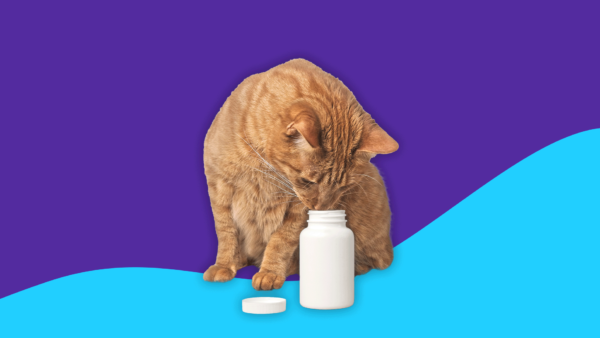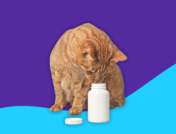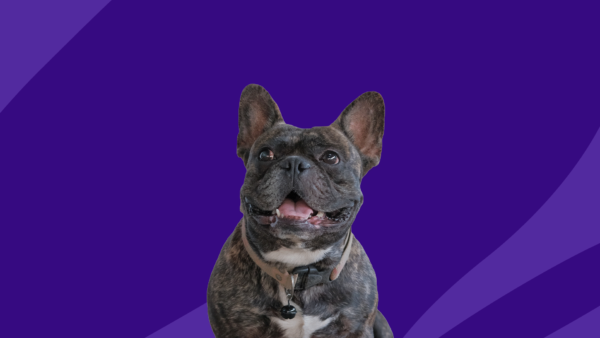Key takeaways
Famotidine (Pepcid) is an over-the-counter H2 blocker drug that helps treat acid reflux, heartburn, and other gastrointestinal issues.
The typical dosage for dogs is 0.25–0.5mg per pound of body weight, although it can vary depending on the dog’s condition.
Famotidine is not FDA-approved for use in dogs, but it’s generally considered safe, and many veterinarians trust it. It may interact with certain antifungals, some antibiotics, iron salts, fluoxetine, and antacids, but its side effects are minimal.
Always follow the vet’s instructions for administering famotidine. It’s usually best to administer it on an empty stomach in the morning.
Dogs and humans have a lot in common. We both love the outdoors, need companionship, and hog the couch. In addition, we can both experience gastrointestinal issues like acid reflux, heartburn, and stomach irritation, so it’s no surprise that famotidine (brand name: Pepcid AC) works as well for our canine companions as it does for us. This over-the-counter drug blocks histamines to suppress a dog’s stomach acid production and vets often recommend it to prevent or treat esophagus inflammation, gastritis, stomach ulcers, and frequent vomiting.
The standard dosage of famotidine for dogs is 0.25–0.5 mg per pound, although it can vary depending on the condition it’s treating. Read on for all the important details.
RELATED: Famotidine (Pepcid) for dogs
Famotidine dosage for dogs
Dog breeds come in various shapes and sizes, and you wouldn’t want to give a Saint Bernard the same dose as a Chihuahua. So, famotidine dosage depends entirely on the dog’s body weight. The Merck Veterinary Manual says a typical daily dose is 0.5–1 mg per kilogram, around 0.25–0.5 per pound.
However, the dose of famotidine is determined by the dog’s weight and the condition being treated, according to Dr. Amy Attas, DVM, veterinarian and author of Pets and the City: True Tales of a Manhattan House Call Veterinarian. For example, “For decreasing gastric secretion, the dose is lower, it is calculated at 0.1mg/pound of weight twice daily,” she says. “For more serious conditions, such as gastric ulceration, the dose starts at 1 mg/pound, and it would be given intravenously.”
Here’s what Plumb’s Veterinary Drug Manual recommends for other conditions:
- To reduce stomach acid concentrations: 0.1–0.5 mg/kg given orally or by injection every 12 or 24 hours
- For esophagitis: 0.5–1.1 mg/kg given orally every 12 or 24 hours
- As an add-on treatment to prevent/treat ulcers associated with mast cell tumors: 0.5 mg/kg every 24 hours
- As an add-on treatment for gastrointestinal problems due to chronic kidney disease, 0.5 mg/kg given orally once per day
How much famotidine can I give my dog?
For humans, famotidine is typically a short-term treatment since it can lose efficacy over time. For example, the label information says most patients take it for four weeks or fewer, and there’s rarely a reason to take it for longer than 6–8 weeks. Per Dr. Attas, long-term use can decrease famotidine’s efficacy, and “there are other medications that provide better gastric acid suppression (e.g., omeprazole) that can be used long-term without a decrease in efficacy.”
If the dog’s symptoms last longer than several weeks, contact the vet for next steps. “Continuous monitoring by a veterinarian is crucial to determine the appropriate duration of famotidine therapy for each dog,” says Dr. Sabrina Kong, DVM, a Staff Veterinarian Writer at WeLoveDoodles.
Based on the average 0.25–0.5mg/pound dosage, here’s how much famotidine may work for dogs. Remember, it depends on the condition, and always follow the vet’s instructions. Also, watch for symptoms of famotidine overdose, which include diarrhea, vomiting, pale gums, and a loss of appetite.
Famotidine for dogs dosage chart |
|
| Weight | Dosage |
| Under 10 lbs | 2.5 mg |
| 10-19 lbs | 5 mg |
| 20-29 lbs | 10 mg |
| 30-39 lbs | 15 mg |
| 40-59 lbs | 20 mg |
| 60-79 lbs | 30 mg |
| 80-100 lbs | 40 mg |
| 101-119 lbs | 50 mg |
| 120 lbs and over | 60 mg |
Does famotidine interact with any other dog medications?
Famotidine is generally safe when administered in the proper dose, “but it can interact with other medications, potentially altering their effects. For example, its action on stomach acidity can affect the absorption of certain drugs,” says Dr. Kong. These drug interactions include:
- Azole antifungals: Because famotidine reduces gastric acid, it can also reduce the effectiveness of ketoconazole, itraconazole, and other antifungals.
- Certain antibiotics: Like antifungals, famotidine can decrease the absorption of cefpodoxime and cefuroxime by decreasing stomach acid production.
- Fluoxetine: Using fluoxetine and famotidine together can increase the risk of an irregular heartbeat or faster heart rate.
- Iron salts: Decreased gastric acid secretion can also decrease the rate of iron absorption.
- Antacids: Antacids can decrease the rate of famotidine absorption.
Tell the vet if your dog takes any of these medications before administering famotidine tablets.
Other famotidine precautions
Famotidine and other H2-receptor antagonists, such as Prilosec (omeprazole), Tagamet (cimetidine), and Zantac (ranitidine), are pretty safe for dogs under most circumstances. Still, it’s best to inform the vet if your dog has heart, kidney, or liver disease or is taking other drugs or supplements. Also, use caution when administering famotidine to a senior, pregnant, or nursing dog.
In rare cases, dogs may also have an allergic reaction to famotidine. Contact your veterinarian immediately if you notice a rash, fever, facial swelling, or trouble breathing.
Guidelines for administering famotidine in dogs
“Famotidine can be administered orally, with or without food. However, administering the medication without food may enhance its effectiveness in reducing stomach acid,” says Dr. Kong. Once a dog eats, it can stimulate gastric activity, potentially reducing the drug’s effectiveness, so it’s usually best to administer the drug on an empty stomach before the dog’s first meal of the day. Nevertheless, if the dog shows signs of upset stomach, vomiting, or other digestive issues, try giving the medication with food or a treat.
Treats can also be a good motivator, according to Dr. Attas. If your dog doesn’t want to take famotidine, “The pill can be hidden in a favorite treat, peanut butter, cream cheese, or other sticky, flavorful substance,” she says.
Some dogs may refuse to take a famotidine tablet on their own, either with or without treats, so you might have to administer it by hand. Sit the dog in a comfortable spot, then gently grab their top muzzle and tilt their head toward the ceiling, which should cause their mouth to open slightly. Use the other hand to put the pill as far back on the dog’s tongue as possible, then close their mouth and lower their head back to a normal position. You can encourage swallowing by massaging the dog’s throat or blowing on their nose.
Store famotidine at room temperature, and if you miss a dose, just administer it as soon as you can, then give the next dose as scheduled. Never give a double dose to make up for a missed dose. Don’t stop the treatment until the vet says it’s okay since this can cause the dog’s stomach to rebound by overproducing acid.
Sources
- Antiulcerative drugs, Merck Veterinary Manual
- Plumb’s Veterinary Drug Manual
- Repeated famotidine administration results in a diminished effect on intragastric pH in dogs, Journal of Veterinary Internal Medicine (2016)
- Famotidine tablet label information, DailyMed
- Gastrointestinal drugs (toxicity), Merck Veterinary Manual
- Famotidine highlights of prescribing information, U.S. Food and Drug Administration
- Is Pepto-Bismol safe for dogs?, American Kennel Club (2024)











